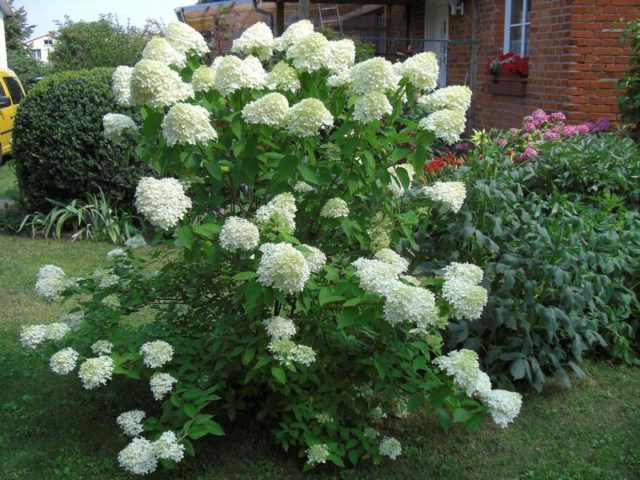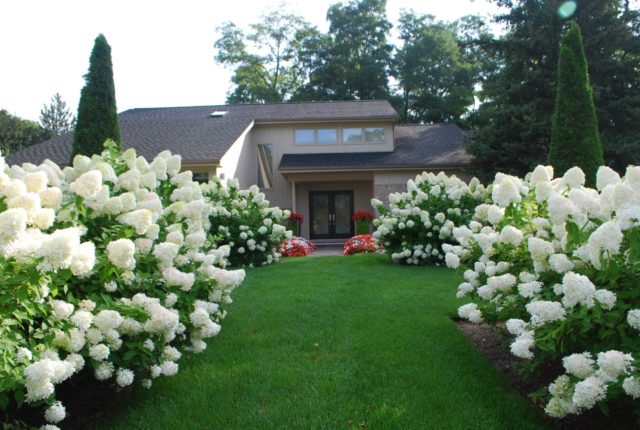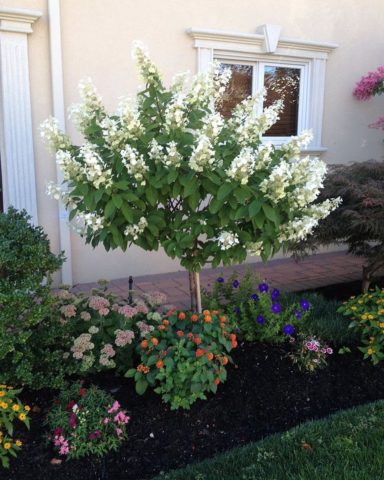Content
Hydrangea Earley Senseishen is one of the varieties of panicle hydrangea. It is a rather tall shrub, sometimes up to 2 m. The culture is often used in landscape design. It can be planted separately, combined with other plants. The flowers of the Erle Senseishen hydrangea resemble lilacs, but they bloom almost throughout the season.
Description of hydrangea paniculata Erle Senseishen

The Earley Sensen shrub blooms throughout the season
Flowering culture begins in June and continues until the end of the season. The shrub began to grow in Holland. It is believed to have been bred by accident in 1991, and in 2006 it was introduced to the international market under the name Earley Sensenion (Early Sensation). The shrub is covered with bright large leaves with small denticles. Shoots are straight, dark in color. Inflorescences can form on young shoots and on those left over from the last season. Their length sometimes reaches 30 cm, a fully open flower is about 3-5 cm in diameter. Today, the shrub is successfully grown in all regions of Russia. The life span of a culture is more than 50 years, therefore it is classified as a perennial plant.
Early Sensation panicle hydrangea is also interesting because the color of the flowers can change. Initially, the petals are creamy and then change to pink. After all the petals open fully, they turn red or burgundy.
Hydrangea Earley Sensation in landscape design
Earley Senseishen is popular and is readily used in landscape design, since it is this type of shrub that blooms for the longest time and can decorate any site. When choosing a variety of panicle hydrangea, take into account the following factors:
- long flowering period;
- neat, decorative look of culture;
- minimal care;
- high resistance to various diseases and pests.
Early Senseishen has all of the above characteristics, so many florists are a favorite. It is important to organize proper care of the plant and then you can grow a hydrangea in the form of a trunk, as an element of a hedge, or just on the lawn with a group of other perennials.
Winter hardiness of hydrangea Erly Senseishen

Inflorescences change color as the bud opens
The panicle hydrangea variety Hydrangea Paniculata Early Sensation is considered a very winter hardy variety. This significantly distinguishes this crop from other varieties of hydrangeas. An adult plant easily tolerates low temperatures (down to -28 ° C), however, if they are short-lived. In harsher climates, Early Senseishen is insulated for the cold season.
In the event that the region of residence requires warming the plant for the winter, you will need pine needles, chopped bark, sawdust and straw.Even when some parts of the plant freeze slightly, with the onset of spring they are able to quickly recover without harming the condition of the shrub. Well increases frost resistance with abundant watering of Airlie Senseishen in the fall.
Planting and caring for hydrangea paniculata Erly Senseishen
Hydrangea care is pretty simple. You only need to adjust the feeding and watering regime. It should be noted that hydrangea does not like excess moisture - this can destroy it. It is also necessary to properly and timely prune the shrub. In order for the plant to please with flowering for a long time and not cause problems in the future, important planting rules must be observed.
Selection and preparation of the landing site
Earley Senseon grows well in temperate climates. He will need a comfortable place and growing environment:
- a young seedling needs soil with a slightly acidic reaction;
- lack of drafts;
- good lighting - preferably western or eastern;
- moderate humidity - landing in a lowland is excluded;
- distance from buildings or fences from 1.5 m.
Also, before planting, you should know that hydrangea does not bloom in a thick shade, and the sun's rays contribute to abundant lush flowering. Then you need to prepare a hole 70 cm deep, a suitable fertilizer, for example, superphosphate, and you will also need a soil mixture consisting of humus, peat, black soil and a small amount of sand.
Landing rules

Varieties of hydrangea paniculata are used as a hedge
Earle Sensation and other types of hydrangeas take root better if transplanted in early September. In this case, the shrub will have the opportunity to adapt to new conditions before the first frost. Many plant a young plant in early March, when the frost is already over. Landing at both times has its drawbacks. In autumn, with early frosts, the shrub sometimes does not have time to take root in the soil, but if the planting was successful, then in the spring the bush will delight with early flowering. The disadvantages of spring planting of a seedling include unexpected frosts after a steady warming. At best, the shrub will start flowering too late, at worst, it will die.
Watering and feeding
Watering is one of the essential ingredients for proper hydrangea care. To maintain the required humidity, it is enough to water the shrub twice a week. For these purposes, it is better to use rain or settled water at room temperature. Of course, the weather conditions must be taken into account. With heavy rainfall, watering should be reduced to 1 time in 2 weeks.
Many gardeners note a certain drawback of panicle hydrangea - intolerance to excessive air humidity. This often leads to the appearance of dark spots on the stem of the crop. As a rule, with the observance of competent soil care, regulating acidity, fertility, moisture, these problems can be avoided.
You need to feed with fertilizers with trace elements in the composition, and at the time of bud formation, a repeated feeding procedure will be required. Mulching of panicle hydrangea is carried out using peat or sawdust in a layer to a depth of 6 cm, leaving free space near the base of the trunk. The loosening process can be combined with weeding.
Pruning hydrangea by Erle Senseishen

One of the important characteristics of panicle hydrangea is frost resistance.
To preserve the decorative effect of the shrub, you need to make timely pruning every year. It is necessary for sanitary purposes and to prolong the youth of the hydrangea. Spring is the best time for this event. Cut the bush before the leaves appear. All weak, damaged branches must be cut off, and the most developed are cut off, leaving 2-3 buds on them. A very young shrub is not touched, since the crown is formed within 4 years. In the fall, you can shorten the shoots by cutting off the ends.This will save the branches from the effects of frost and get abundant flowering in the spring.
Preparing for winter
Earley Senseishen is a very frost-resistant plant, tolerates low temperatures, but short-term. In winter, it feels great without covering material. However, if the hydrangea grows in harsh conditions or the age of the culture is young, then protection from frost and winds will be required.
Reproduction
Earley Sensation can be propagated in several ways:
- Division of the bush. Before the procedure, the shrub is well watered, dug out and the roots are freed from excess soil. Then carefully divide it into several parts and plant it separately from each other.
- Cuttings. Cuttings can be prepared while pruning the plant. This is the most popular propagation method for many plants because it is the simplest.
- With the help of layering. Layers are shoots from the base of the shrub. For breeding, they can be added in early spring.
Each of the breeding methods has its own pros and cons.
Diseases and pests

Some types of panicle hydrangea are grown on a stem
Hydrangea Earley Senseiion is resistant to many types of disease, especially if it is properly cared for. The culture can suffer from some fungal diseases - rust, gray rot, septoria. If signs of these diseases are found, the damaged areas should be removed and treated with an antifungal agent.
As for insect pests, most often the plant is exposed to aphids, spider mites. Pests significantly slow down the development of the shrub, so you need to process the plant as soon as possible.
Conclusion
Hydrangea Early Senseishen is a beautiful perennial plant. Flower growers are attracted by unpretentious care, incredible frost resistance, flowering throughout the season. Erle Senseishen does not require special care. It is important to prune, mulch, feed on time, set the correct irrigation regime and the hydrangea will delight with flowering throughout the season.








